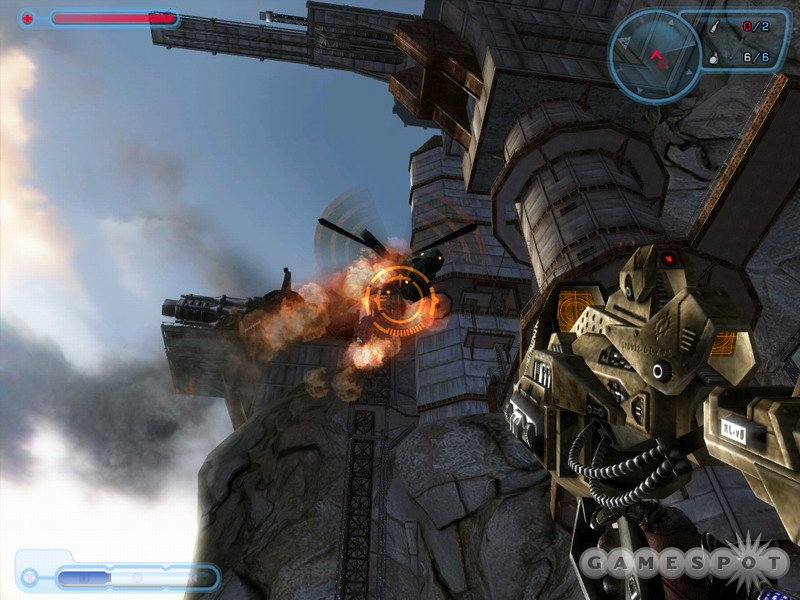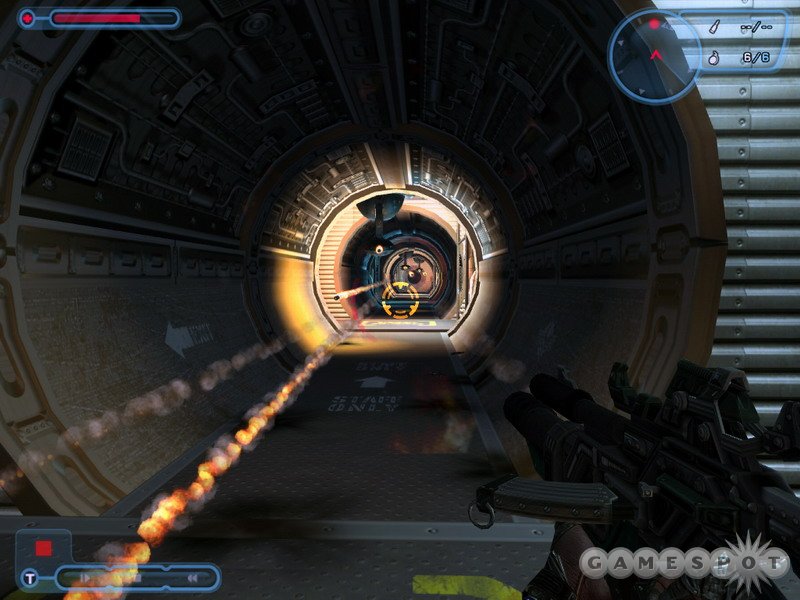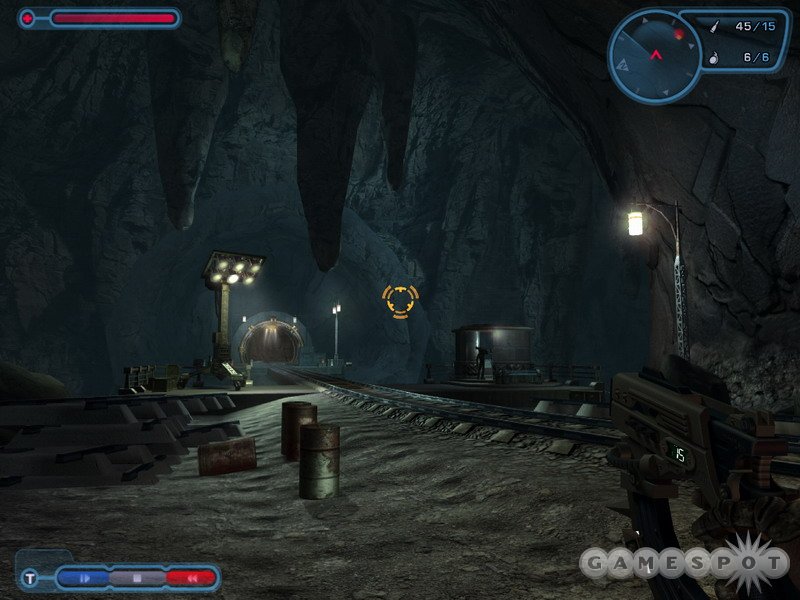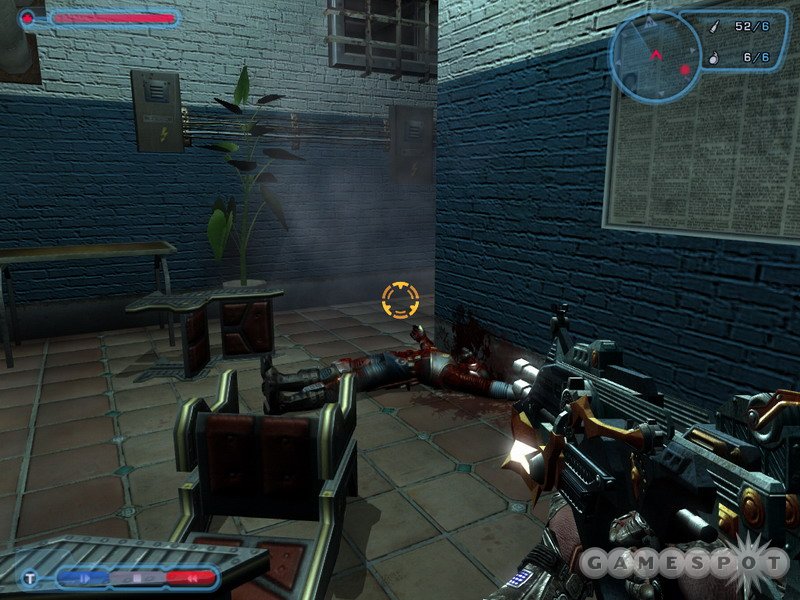TimeShift Designer Diary #1 - The History of TimeShift
Saber Interactive CEO Matthew Karch gives us the history and ideas behind TimeShift, and tells us why this cutting-edge shooter is being made in beautiful St. Petersburg, Russia.
While the idea of "bullet time," or slow motion, is hardly a new idea in action games, TimeShift, from Atari and developer Saber Interactive, promises to take the idea of time manipulation to a whole new level. In this upcoming first-person shooter, you are a scientist testing out an experimental time suit, only to discover that someone has beat you to it and has altered history. Now it's up to you to undo the damage. In addition to an arsenal of weapons, you have your suit's powers at your disposal. You can not only slow and pause time, but even reverse time around you. This will let you do lots of cool new things that you've never seen in a shooter. For example, if you need to reach a high ledge, simply blast a few rocks to the ground, then pause time, climb on the rocks, and then reverse time to "ride" to the top. To explain this further, Saber CEO Matthew Karch fills us in on TimeShift. The game will ship for the Xbox 360 in the spring, with the PC version to follow sometime after.

The History of TimeShift
Matthew KarchCEO, Saber Interactive
If there is an environment more conducive to game development than St. Petersburg, Russia, in the dead of winter, then I don't know where it is. With temperatures regularly well below freezing, roads and sidewalks slicked over in a sheen of solid ice, and just a couple of hours of sunlight each day, there is nowhere better to be than inside a nice warm, brightly lit room. Now, don't get me wrong, St. Petersburg is a beautiful place in every sense of the word. Beautiful architecture, beautiful parks and canals, and, of course, beautiful women, but when your spit freezes before it hits the sidewalk, there is no time and even less desire to stand and admire the scenery. Your only thought is to get inside and thaw your feet. And where could it possibly be warmer and brighter than an office packed with overclocked PCs and monitors?
It is in such an environment that the guys and gals of Saber Interactive spend most of their waking hours working on TimeShift, our upcoming time-bending shooter for the Xbox 360 and PC. We are in full crunch mode now. We are polishing the artificial intelligence and animations, integrating full-motion videos, testing our multiplayer and single-player modes, and, of course, fixing the bugs that tend to creep into the code during development. We are fortunate that we have plenty of time to polish the game. As any seasoned developer will tell you, good games become great games in the last few months of development. If we stay the course, we will have a truly great game on our hands.
In this first segment of the TimeShift diaries, I am going to share with you a little bit about the design origins of TimeShift and why we at Saber and Atari are so excited about the game.

When we came up with the design of TimeShift, our only design constraint was the genre. We knew that we wanted to create a first-person shooter, but we also knew that we wanted it to be different from the slew of shooters currently in the pipeline. It is tough to compete and differentiate in a market with so many brand names, no matter how brilliant the implementation. We thought about things that could really set TimeShift apart from the pack of AAA shooters: Story? Nah, everyone can claim to have a unique story. Weapon and opponent design? They are important, but not in themselves enough to create a really different and innovative gameplay experience. So, what then? We needed to take it further, to do something that really changed the gameplay in some fundamental way. And then it came to us: Let's play with the idea of time manipulation and combine it with classic first-person shooting combat. If implemented the right way, we could really have something different on our hands. Now, when we say "time manipulation," we are not talking about Max Payne-style slow-mo that looks cool but has little gameplay applicability. We are talking about giving the player the ability to slow, stop, and reverse time while he continues to move around the gameworld in real-time.
Time Is On Your Side
Once we had the idea, the next challenge was to convert it into a working gameplay mechanic. This is easier said than done. The first concern is always a technical one. While stop and slow were more or less straightforward, time reversal was a major challenge. How do you store and reverse gameplay data in real-time? As anyone who has ever tried to record game footage to the hard drive knows, your frame rate can really chug as you record massive amounts of data. So the challenge was to develop a highly optimized system that would let us record everything that happens in the gameworld in real-time. Then we needed to implement a system that enables the player to navigate this world while absolutely everything else in the game--from animations to explosions to particles to AI states--moves backwards around him. Luckily, we have a few very smart guys on our team who were able to resolve the issue in a surprisingly quick time frame. The concept was simple: Let's create literally hundreds of game quicksaves, ignore player-related data, and then play them in reverse. 
OK, so we got it working, but is it fun? To make it fun we had to come up with compelling gameplay scenarios and in-game challenges to play around with. Once we got the time-manipulation prototypes working we were able to experiment, and the ideas began to flow. We started to come up with hundreds of ideas, many of which ultimately made it into the game: ideas such as, "Hey, let's steal weapons out of opponents' hands during time-stop." Or, "Let's allow the player to shoot stuff down, climb on it, reverse time, and defy gravity by riding the reversed objects back up to where they came from." Or, "Let's create opponents with guided missiles that track the player as he moves so that the only way to avoid the tracking is to stop or slow time and get the hell away." The more we thought about it, the more we tooled around with the prototypes; and the more we tested the gameplay, the more ideas we came up with. The key was that all the ideas had to operate under consistent rules, and after we had established these rules (how long each power lasted, how long it took to recharge the powers, and how the player could interact with the environment during the use of the powers), we were able to dig deeper into preproduction and create a complete game design. We then got a writer on board to assist us in creating a story around the gameworld and gameplay mechanic that we created.
We are now in the home stretch of development and are thoroughly testing the game and tweaking the time-shifting mechanic. The game is really exceeding even our own initial expectations, and we can't wait to get it on the shelves. One of the things that we have learned is that while gamers find the concept intriguing when they hear about it, they don't really appreciate the "cool" factor until they have seen the game in action. I have also read some of the forums (yes, developers do read what the gaming public has to say about the games) and have seen comments such as "it's been done before" about time-control gameplay. There is no real way for me to respond to this, other than to say that you really have to get your hands on the game to see how different it is. We have made the time-shift mechanic more than a gimmicky add-on. It is a fully-integrated, essential element of the game. For many hardcore shooting fans, this will be an entirely new experience. While the fast-twitch shooting skills are crucial, it is also necessary to master the power to shift time and to understand how it works in the game. This makes the game similar to, but also very different than, the standard shooters. Time really does add that "fourth dimension" to the gameplay experience.

As I record these rambling thoughts to paper, I am sitting in a Starbucks in La Jolla, California, taking a break from our intensive sessions of voice-over recordings. I am just a short walk from the beach right now, and as I sit here, I wonder how the hell all these developers out here ever get any work done with so many distractions. My advice to my industry cohorts is simple: When crunch time hits, grab your visas, jump on a plane, and head to a place like Russia in the winter, a place with fewer distractions...or at least with more reasons to stay inside.
Got a news tip or want to contact us directly? Email news@gamespot.com
Join the conversation